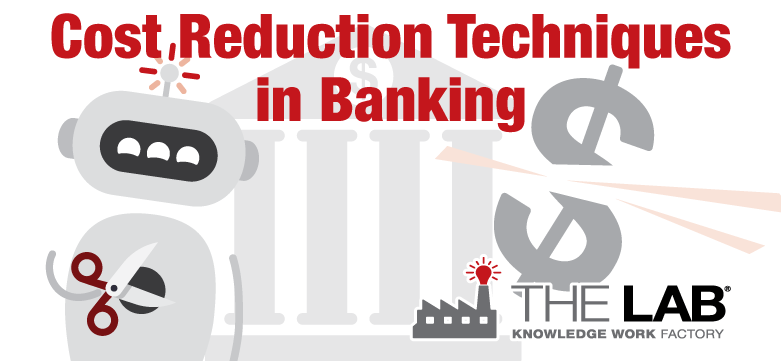The most recent article in this series described a three-pronged approach to improving operational efficiency in the banking sector. It pointed out ways to find employee under-utilization issues hiding in plain sight.
This article, by contrast, is a case study. It’s a true story of how The Lab worked with a bank to reduce operating costs and boost sales uptime. And it reveals four quick-hit areas for improvement, based on that engagement.
Cost reduction techniques in banks: Retail banking operations
This story concerns a prominent retail bank in Canada boasting $27 billion in annual revenues. Things were good, but they could’ve been better. That’s why senior management contacted The Lab for this engagement. Their goals were manifold:
- Improve customer service.
- Increase sales uptime in branches.
- Simplify processes.
- Reduce costs.
Specifically, they sought to take administrative and clerical work off the desks of their branch salespeople. They wanted it moved to the back office, where it belonged. This would free up the salespeople to spend more time doing what they do best: selling.
Simplifying these processes, however, wasn’t so simple. It required careful analysis of the situation.
Bank cost cutting begins with scrutiny of processes
In this case, The Lab spent eight weeks analyzing every aspect of the processing of a product or service in the bank’s retail branches. The offerings under study included personal deposit accounts, mortgages, credit cards, and loans.
But that’s not all. Support areas were scrutinized, too. These included the customer contact center, the internal contact center, underwriting, and compliance functions such as fraud and anti-money laundering.
In all, more than 210 improvements were identified. And not a single one required the implementation, or cost, of new technology.
Quick-hit bank cost reduction technique # 1: Reduce sales administrative tasks
The study revealed that the percentage of time that a given salesperson spent face-to-face with actual customers was low. Why? Their time was being wasted on the complex processing of documents and compliance tasks.
Ask yourself: 1) Are there opportunities for cost cutting measures in your bank, based on the uptime—or lack thereof—of your sales force? And 2) Would new technology (and its expense) really be the solution? Most likely, your answers are 1) Yes, and 2) No.
Quick-hit bank cost reduction technique # 2: Shorten end-to-end service cycles
This bank provided services across various departments. But each was maintained separately. As a result, no one really knew how long a given service should take to complete. That’s because the answer varied by department. And the departments weren’t communicating well.
This killed the sales team. They couldn’t provide their customers with accurate estimates to basic questions such as “When will my loan be processed?” And the salespeople’s time was further wasted trying to get updates from the other departments in the bank.
Does this scenario feel uncomfortably familiar to you? If it does, you’ve got a quick-hit opportunity for a cost reduction technique in your bank.
Quick-hit bank cost reduction technique # 3: Streamline task sequencing
The order in which activities take place is crucial to containing costs in your bank. In this Canadian bank, the processing of loans and other products didn’t always follow a rational sequence. For example, the fraud team would identify accounts for rejection, days before the anti-money laundering team would complete its own document analysis. This meant that the anti-money laundering team was basically wasting its time, analyzing an account that had already been rejected!
Redesigning the steps of a process can save effort and expense. So can improved communication between departments.
Unfortunately, the out-of-sync processes at this Canadian bank are all too common in banks worldwide. Do you see a quick-hit cost-cutting opportunity in your bank, based on the simple sequencing of processes?
Quick-hit bank cost reduction technique # 4: Standardize technology workarounds
This bank was in the process of implementing new technology. But it wasn’t going to be ready for another 18 months. That meant that everyone needed to know the best ways to deal with the existing technology in the bank.
How did The Lab help? We identified employees and areas that were demonstrating internal best practices for using the existing system. The workarounds that they developed were then shared across the company, making it as efficient as possible while the new technology was still being installed.
You might not think that old technology can hand you an improvement opportunity, even while new technology is on its way. But that’s exactly what happened here.
Six-month scorecard: Cost cutting strategies for banks pay off
This engagement was supposed to fund itself in just six months. But it didn’t. It broke even in just four months. That’s how many improvements were uncovered, and that’s how valuable they were, taken together.
Consider some of these other decidedly quick wins:
- Sales uptime increased by 15 percent.
- Operating costs plummeted by 12 percent.
- Annual savings totaled $79 million.
- Twelve-month ROI on the engagement was tenfold.
Self-funding improvement initiatives like this aren’t rare events. At The Lab, we do them all the time. In our next article, we’ll share more insights about process improvement ideas in banking. But before you read it, read more about how The Lab specializes in cost reduction techniques in banks. Not only are our engagements self-funding. Our work is money-back guaranteed. Learn more here.
Real results. Real fast.
The Lab can get your first banking bot up and running in just weeks. It’s an irresistible offer, made all the more enticing by the fact that you don’t have to force this change on your workforce. Once they see it in action, they’ll be clamoring for more.
Call The Lab at (201) 526-1200 or email info@thelabconsulting.com today for your free, no-obligation 30-minute screen-sharing demo. You’ll love it!
For 2021: We have updated our bank client offering. Much of these findings and implementation results can be reviewed in the 3-part-series of “Big Rocks for Banks” below. Find out how to strategically lower costs, increase operating leverage, improve customer experience, and automate what previously wasn’t automatable in your bank.
Find them all here:





















